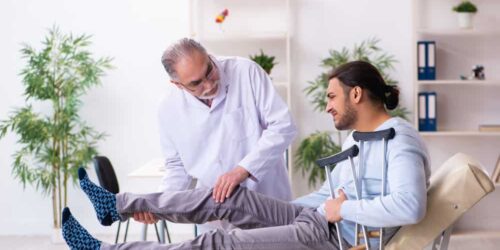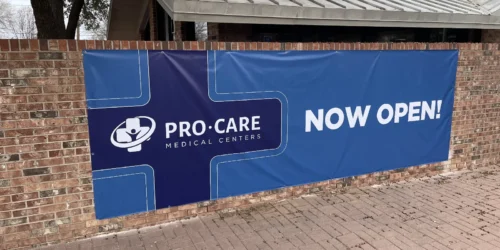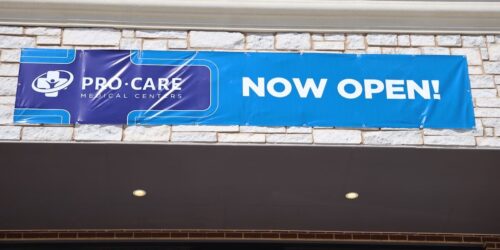You probably do not give your shoulder much thought when it is working properly. But as soon as you start noticing pain or discomfort, it can start to negatively impact your quality of life. You may not realize just how often you use your shoulders for even the smallest of daily tasks until pain keeps you from those activities. The shoulder joint is a ball and socket joint comprised of three bones: the shoulder blade, upper arm bone, and collarbone. Thick bands of tissue support the shoulder joint, including the shoulder’s labrum. Damage to tissues that support and connect bones in the shoulder joint can lead to a shoulder labral tear. Learn more about shoulder labral tear symptoms, diagnosis, and treatment, and how chiropractic therapy can help!
3 Types of Shoulder Labrum Tears
The labrum of your shoulder joint is made up of soft tissues that surround the shoulder socket and help provide stability for the joint. Your shoulder labrum and rotator cuff work together to help keep your arm safely in the shoulder socket. Soft tissues also provide joints with a cushion between bones so that they do not rub against one another. A shoulder labrum tear can result in not having enough cushion between the bones in your shoulder joint, which can cause significant pain and other symptoms. Here are the three main types of shoulder labrum tears.
SLAP Tear
A shoulder labrum SLAP tear occurs in a specific part of the shoulder joint. SLAP stands for superior labrum anterior and posterior. A labrum SLAP tear in the shoulder joint refers to where the labrum attaches to the bicep tendon. A tear can occur from the front to the back of where the labrum attaches to the tendon of the bicep. Injury or damage to the bicep tendon can also increase the occurrence of a shoulder labrum SLAP tear. A SLAP tear is the most common type of shoulder labrum tear.
Bankart Tear
A Bankart tear or lesion refers to a shoulder labral tear that occurs in the lower half of the shoulder socket. This type of tear or lesion of the shoulder labrum is most commonly associated with children and young adults who have suffered a dislocated shoulder.
Posterior Labrum Tear
A posterior labrum tear is a rare type of shoulder labral tear that occurs in the back of the shoulder. This type of shoulder labral tear can lead to intermittent symptoms and only occurs in 5-10% of shoulder labral tear patients.
Symptoms of a Shoulder Labrum Tear
The most common symptoms of a shoulder labrum tear can occur intermittently. This means you may not notice pain or other symptoms all the time, and certain symptoms may come and go. Certain movements and overhead activity can cause an increase in symptoms. Symptoms of shoulder labrum tear include an unstable feeling in the shoulder joint and a reduced range of motion. You may notice that your shoulder makes a catching, locking, or grinding sensation during certain movements. A shoulder labrum tear can also cause a loss of strength in the shoulder and surrounding musculature. Shoulder labrum tear symptoms may increase at night, especially if you tend to sleep on your side, which puts more pressure on the shoulder joint.
Causes of a Shoulder Labrum Tear
There are three main causes of a shoulder labrum tear: an overuse injury, an acute injury, or joint degeneration. A shoulder labrum tear can be caused by an injury to the tissue itself or to surrounding tissues like the rotator cuff. Here are examples of all three causes and potential risk factors for a shoulder labral tear.
Overuse Injury
A SLAP shoulder labral tear is a common overuse injury in athletes, especially tennis players and baseball players. Athletes who perform regular overhead arm motions are at greater risk for developing an overuse injury to the shoulder labrum. Whenever you perform the same or similar movements over and over, it can put added stress and pressure on your joints. Overuse of the shoulder joint can lead to a shoulder labral tear.
Acute Injury
An acute injury refers to a sudden or traumatic injury, like a fall or blow to the shoulder. When you slip, you may naturally reach out to try and stabilize yourself. When you try to break your fall with your arms outstretched, it can cause a sudden injury in your shoulder, like a SLAP tear. A direct hit or blow to the shoulder can also disrupt the joint and cause tissues to tear. A sudden tug or pull on your arm can also lead to a shoulder labral tear. A dislocated shoulder can also lead to a shoulder labrum tear.
Joint Degeneration
Regular wear and tear on the joints can lead to degeneration over time. As you age, your joints tend to become stiffer and make certain movements more difficult. Joint degeneration is common and tends to affect people over 40 years of age. The general wear and tear on your body over time can make you more susceptible to suffering an injury like a shoulder labral tear.
Diagnosing a Shoulder Labrum Tear
A shoulder labral tear can occur in different parts of the shoulder joint and cause a range of symptoms. In order to determine what type of labral tear you have suffered, your doctor will need to gather more information.
Medical History
Talk to your doctor if you know the specific instance that led to the shoulder labrum tear. You may recall a sudden injury or overuse injury that affected one of your shoulders. Your doctor will also want to know what symptoms you have been experiencing. Talk to your doctor about when you first noticed the symptoms, how often they occur, and if any specific movements or activities make your symptoms worse.
Physical Examination
Your doctor will then perform a physical examination of the shoulder. A physical exam will allow your doctor to feel the structure of your shoulder joint and palpate for any potential issue. Your doctor may also compare your injured shoulder to the healthy functioning shoulder to see if there is a marked difference. They may also ask you to move your arm and shoulder around and into different positions to test your mobility and stability.
Diagnostic Imaging
Diagnostic imaging tools like an X-ray, CT scan, or MRI can also be helpful in diagnosing a shoulder labrum tear. An X-ray can also help to rule out other injuries, like a broken bone that may be causing you pain. If you suffered a sudden shoulder injury, then a CT scan may be used to rule out other injuries as well, like a rotator cuff tear or a pinched nerve. Your doctor may request an MRI with contrast, which involves injecting a dye that helps provide more contrast in your shoulder joint. An MRI will be able to detect a shoulder labrum tear.
Treatment Options for a Shoulder Labrum Tear
More conservative treatment options are typically recommended for a shoulder labrum tear. Your doctor will likely recommend a combination of at-home remedies, stretches, and exercises to help support your treatment and recovery. Here are three treatment options for a shoulder labral tear.
At-Home Remedies
Inflammation and swelling can occur after a shoulder labral tear, which can cause an increase in pain and discomfort. Your doctor may recommend at-home remedies like anti-inflammatory medications and cold compresses to help reduce swelling and inflammation. A minor SLAP tear may resolve with at-home remedies. Resting the area will also help reduce swelling and inflammation. You will want to avoid activities that make your pain worse or exacerbate the injury. If you suffered a shoulder labral tear while playing a sport or participating in a regular activity, then you may need to take a break until your shoulder can fully heal.
Stretches & Exercises
Stretching and exercising your upper body can also help support your recovery process. Strengthening the shoulder and rotator cuff can help provide more stability for the joint. When you stretch your affected shoulder, it can help to gradually improve your range of motion. Stretches and exercises help provide strength and support to the entire shoulder joint so that the labral tear can heal naturally. As you gain strength, this can also help prevent future injuries or tears of the shoulder labrum. The severity of your injury will inform how soon you will be able to resume regular activities. Your doctor may also talk to you about certain stretches and exercises that you can do at home during various parts of your recovery process.
Chiropractic Care
Chiropractic care can be a great option for treating a shoulder labrum tear. A chiropractor can use gentle and safe chiropractic adjustments to the neck, back, and shoulder to help reduce strain and pressure on the joint. Misalignments in your shoulder joint, neck, and back can end up putting additional strain on the muscles that support your shoulder. Chiropractic care can also include teaching you stretches and exercises to strengthen and stabilize the shoulder joint. You may consider chiropractic care for treatment for a shoulder labral tear as a natural alternative to surgical interventions. Chiropractic care can also be beneficial for recovering from surgery if it is required for a severe labral tear. Your chiropractor can work with you on passive and active exercises to help you regain movement and range of motion in your shoulder. Passive exercises involve you and your chiropractor gently moving the arm while you heal. Moving to active exercises when you are able will help increase strength and support in your shoulder muscles.
Recovering from a Shoulder Labral Tear
A minor shoulder labral tear may take 6-8 weeks to heal, on average. If your shoulder labral tear required surgical intervention, then it could take up to a year for a full recovery. After surgery for a shoulder labral tear, you will typically wear a sling to reduce mobility in the shoulder joint while you heal. Then chiropractic care and physical therapy can help you safely and effectively regain your range of motion and improve your strength. While surgery for a labral tear is typically minimally invasive, it will still require a significantly longer recovery period and will limit your range of motion. Your doctor will recommend when you can return to certain activities during your healing and recovery period. Shoulder labral tears typically have a positive outlook when treated properly with rest and physical therapy. Treatment for a shoulder labral tear will depend on your specific injury and require personalized attention and care.
Chiropractic Care at Pro-Care Medical Centers
Probably, a shoulder labral tear is one thing you didn’t know a chiropractor can help with. At Pro-Care Medical Centers, we offer a wide range of services, including primary care doctors and chiropractic therapy. We understand the value of price transparency in healthcare and do our best to clearly communicate expectations upfront. With locations in Austin, Cedar Park, and San Antonio, we offer local communities an easy and accessible option for chiropractic and primary care. Chiropractic therapy offers a total-body approach to your health and wellness, including injury treatment and recovery. Our team includes top-rated chiropractors who offer injury treatment and rehabilitation. We also offer additional services, including family medicine, exams, evaluations, and primary care and wellness.
Visit a Pro-Care Medical Center near you to find out more about our convenient appointments and Pro-Care SMART Sessions for intensive therapy and injury recovery. Our team of chiropractors and primary care providers work together to provide you with a treatment strategy that addresses your specific healthcare goals and needs. We offer onsite X-rays and spaces for rehabilitation so you can get the quality and comprehensive care you need all in one convenient location. Take care of all your healthcare needs at Pro-Care, where you can meet with your primary care physician and come for chiropractic therapy all in one place. Our walk-in clinics allow you to get the attention and care you need when you need it. Easily schedule an appointment online to get started at Pro-Care today!



